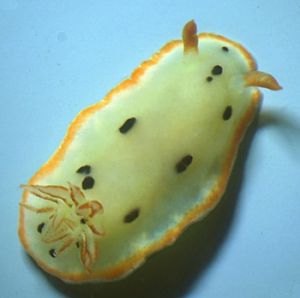
Chromodoris orientalis
Rudman, 1983
Order: NUDIBRANCHIA
Suborder: DORIDINA
Family: Chromodorididae
DISTRIBUTION
Originally reported from Japan, it is now known from Hong Kong (Orr 1981; Rudman 1983).
PHOTO
Shelter Is. (SE), Port Shelter, 10 m., Hong Kong. [Site 10.10]. 4 June 1983, AM C140157. PHOTO: Brian Darvell.
The white background, large black spots and orange-yellow border to the mantle clearly distinguish this species. The foot is similarly coloured with a few scattered black spots and a row of orange spots along the edge. The rhinophore clubs and the edges of the gills are orange. In Japanese material, at least, the inner edge of the gills can be lined with black rather than orange or yellow. It grows to at least 30 mm. It is similar in colour to Hypselodoris placida but one distinctive difference is the absence of a submarginal band of blue patches in C. orientalis.
This species is one of a group of species in which the egg ribbon is attached flat on the substrate rather than just along one edge (Baba et al, 1956).
References:
• Baba, K., Hamatani, I. & Hisai, K. (1956) Observations on the spawning habits of some of the Japanese Opisthobranchia. 2. Publications of the Seto Marine Biological Laboratory, 5(2): 209-220.
• Rudman, W.B. (1983a) The Chromodorididae (Opisthobranchia: Mollusca) of the Indo-West Pacific: Chromodoris splendida, C. aspersa and Hypselodoris placida colour groups. Zoological Journal of the Linnean Society, 78: 105-173.
• Rudman, W.B. & Darvell, B.W. (1990) Opisthobranch molluscs of Hong Kong. Part 1. Goniodorididae, Onchidorididae, Triophidae, Gymnodorididae, Chromodorididae, (Nudibranchia). Asian Marine Biology, 7: 31-79
Rudman, W.B., 2001 (July 5) Chromodoris orientalis Rudman, 1983. [In] Sea Slug Forum. Australian Museum, Sydney. Available from http://www.seaslugforum.net/find/chroorie
Related messages
Chromodoris orientalis from Sth Korea
April 2, 2007
From: Kevin Lee

Hi Doc,
Recently, I was in South Korea on a business trip and, afterwards, took off a few days to meet and dive with Dr. Dong-Bum Koh, off Jeju Island. All this thanks to connecting with him via the Sea Slug Forum!
Diving Jeju (my first time) was great and I was surprised by the semi-tropical nature of the fauna there. On my first dive, I photographed five species of slugs.
Locality: Mun-Som Islet, 30 feet, Jeju Island, South China Sea/Yellow Sea, 19 March 2007, algae covered rocky substrate. Length: approx. 1.5 inches. Photographer: Kevin Lee.
Curious if the two slugs shown here are both Chromodoris orientalis, as one has round, evenly distributed black spots, whereas the other looks very similar but is covered with a lot of black streaks and blotches, in addition to the round spots. Also, I include an associated, perhaps mimic, flatworm [lower photo ].
Again, thanks for a great forum thru which I've made a nice connection and friend.
K:-)
diverkevin@gmail.com
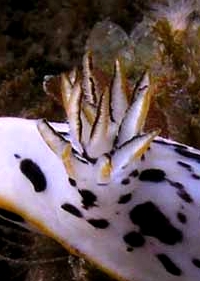


Dear Kevin,
I am glad the Forum has been a way to make new friends as well as see new slugs. I think this is the first time I have seen an example of C. orientalis with such a streaky black pattern. We don't know that much about this species, so its a useful bit of new information. When looking at similarly coloured animals like this, I tend to look for some other feature of the colour pattern to link them or separate them. For example, in both your specimens the translucent white gills have an orange-yellow line along the outer edge and a black one along the inner edge. This is a very unusual colour pattern which suggests to me that the two are the same species. If you look at other photos of this species on the Forum you will see that the black lines are sometimes brown, and sometimes absent. It's one of those characters whose presence can give you a positive identfication, but whose absence can't really be used.
I would very much like to get photos of this animal laying eggs. As I mention earlier [message #5172], there are reports that it lays a flat egg-ribbon, but on the Forum we have photos of it with a ribbon apparently attached along one edge. It would be valuable to clarify this. It would also be nice to know what type of sponges it feeds on as well.
Thanks also for the flatworm photo. There are a lot of flatworms which look remarkably like particular nudibranchs, but as you suggest, we can't always be sure they are real mimics
Best wishes,
Bill Rudman
Two-headed Chromodoris orientalis from Japan
June 8, 2002
From: Tomohiko Kurihara
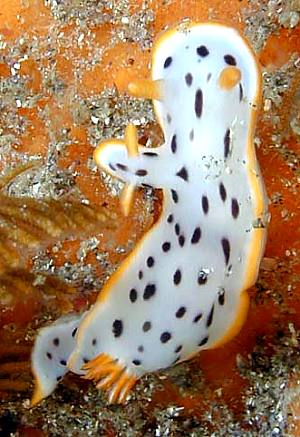

Dear Bill.
I found interesting Chromodoris orientalis at Osezaki, Suruga bay, Japan. At first,I thought that it was copulating. Because I could see two heads. But it was a deformed C.orientalis - it looks like twins, it has two heads and four rhinophores. The second head doesn't have mouth, but it can sway and expand.
Because the spots are closer to the edge of mantle (LOWER PHOTO), I think the smaller head is still growing. What do you think?
Place: Osezaki, Suruga bay, Japan
Date: 28 May 2002
Depth: 32m
Length: 30mm
Best regards,
Tomohiko Kurihara
miyamoto@info.email.ne.jp
Kurihara, T., 2002 (Jun 8) Two-headed Chromodoris orientalis from Japan. [Message in] Sea Slug Forum. Australian Museum, Sydney. Available from http://www.seaslugforum.net/find/7140Dear Tomohiko,
Every day seems to bring a new amazing find from somewhere around the world. We have a saying in English that 'two heads are better than one'. I don't think so in this case. Can you remember whether the rhinophores in the second head were able to retract? If there is no mouth I wonder whether the rhinophores are superficial growths or whether they have nerves connecting them to the slug's 'brain'. Although it is possible that the second head is still growing, most of these faults seem to be a result of something going wrong during embryonic development. However from Nishina Masayoshi's photo of this species' eggs, it seems that it has a veliger larva stage. I guess this means the mistake occurred when the veliger larvae was metamorphosing into a slug. Very few people have studied embryonic development in opisthobranchs. Even if there were more people studying them, the chances of actually observing an embryo developing two heads like this would be very slight indeed.
Best wishes,
Bill Rudman
About Chromodoris orientalis
August 30, 2001
From: Nishina Masayoshi
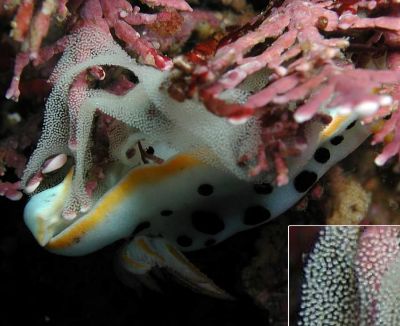
Dear Dr.Rudman,
Thanks for your comments. I believe that a deep yellow mantle border is a more common colour form here. I believe that the pale coloured Chromodoris orientalis we saw and Imamoto sent at Echizen Coast is rather say rare.
I often see the dendritic branching of the mantle glands on C. orientalis here,
but I don't know why sometimes it disappear and sometimes it's very noticeable. Following your comment "The way the inner edge of each gill has a black or dark brown line", I checked all of my photos of C. orientalis and studied their gills.
I believe that this C. orientalis with black or dark brown line is rather common in Japan. C. orientalis with an orange line does occur but not commonly. It is the same on the Pacific coast such as Sagami Bay and Japan Sea coast such as Echizen. So it is not because of geographical reason. I seldom thought that the shade of a color was a feature of gills.
Baba described this species as Glossodoris pallescens(Bergh) in his book Opisthobranchs of Sagami Bay, and he mentioned just "color of gill is yellow" No more detailed description. Here are photos of two different typical gills of C. orientalis'
We are learning many things from the from you through this Forum. I understand now that the form of the egg mass becomes very important data about the species. So we have been trying to find and take a photo of it and have succeeded. This species is present in large numbers at present so it is simple to find it, and observe it.
The photos were all taken at Echizen Coast on 12 Aug, 2001. Length of animals was between 30mm to 40mm.
PS: Yasuhiro also has an interesting photo on his website http://www.sea-slug.com/species/index2.html
Best Regards,
Nishina Masayoshi
nishina@hpe15.wips.co.jp

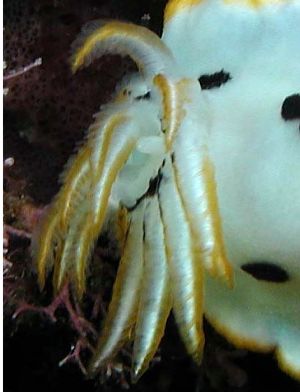

Dear Nishina,
Thanks for all this interesting information. The egg ribbon is rather interesting. Both your photo and Yasuhiro's show an egg ribbon which is attached along one edge, which is different from the 'flattened spiral' that I mentioned that Baba, Hamatani & Hisai had described for this species. Both your photo and Yasuhiro's show an egg ribbon being deposited on coralline algae. Although it doesn't seem very likely, it would be interesting to know if the egg ribbon is laid differently on a rock or other flat surface.
I have attached alongside the drawing from Baba, Hamatani & Hisai, 1956. They say:
"Spawning ... most active from July to early August... In Toyama Bay and Sado Island ... the full grown animals come together in enormous numbers .. copulate and lay eggs .... the egg mass is distinct in being laid flat on the substratum. It consists of a long and ashy white ribbon, coiled tightly in about 2 and a half convolutions ..."
Best wishes,
Bill Rudman
Chromodoris orientalis from Japan
August 29, 2001
From: Nishina Masayoshi
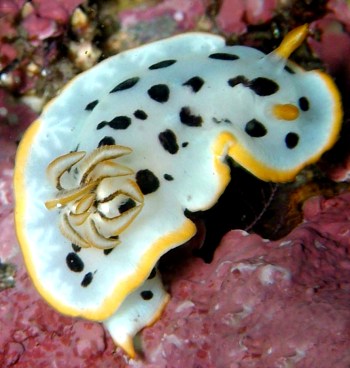

Dr.Rudman,
We are able to see Chromodoris orientalis very commonly in Sagami Bay and on the Echizen Coast of Japan. There is very little colour variation.
UPPER PHOTO: Echizen Coast, Japan
Date: 21 July 2001
Depth: 5m
Length:40mm
LOWER PHOTO: Shiba saki Hayama, Sagami Bay, Japan.
Date: 4 Aug 2001
Depth: 5m
Length: 30mm
Best Regards,
Nishina Masayoshi
nishina@hpe15.wips.co.jp
Nishina, M., 2001 (Aug 29) Chromodoris orientalis from Japan. [Message in] Sea Slug Forum. Australian Museum, Sydney. Available from http://www.seaslugforum.net/find/5158Dear Nishina,
Thanks for your photos. With Jun Imamoto's photos they suggest that the deep yellow mantle border is a more common colour form than the orange-yellow photographed by Brian Darvell in Hong Kong. The dendritic branching of the mantle glands is also very noticeable.
Another interesting point is the way the inner edge of each gill has a black or dark brown line, replacing the orange or yellow line along the outer edge. This feature was not visible in photos of Hong Kong specimens and I can't find reference to it in earlier Japanese records of the species (as Glossodoris pallescens). While checking this point in the literature I noticed a description of the egg ribbon (Baba et al, 1956). This species is apparently one of a group of species in which the egg ribbon is attached flat on the substrate rather than just along one edge. Have you seen any egg masses of this shape nearby?
• Baba, K., Hamatani, I. & Hisai, K. (1956) Observations on the spawning habits of some of the Japanese Opisthobranchia. 2. Publications of the Seto Marine Biological Laboratory, 5(2): 209-220.
Thanks very much,
Bill Rudman
Chromodoris orientalis from Japan
August 29, 2001
From: Jun Imamoto
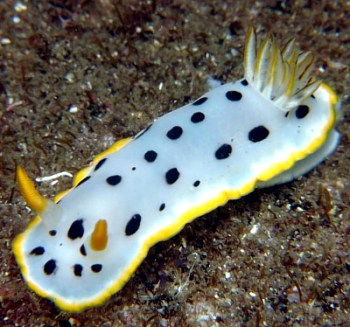
Dear Bill
I went to Echizen coast (Tsuruga Bay, Japan) from August 11 - 12, 2001. I found some Chromodoris orientalis including one which was very pale in color. Is it a colour variation?
Place: Echizen coast (Tsuruga Bay, Japan)
Depth: 4-5m
Size: 25mm (pale variation - LOWER PHOTOS)
Size: 35mm - UPPER PHOTO
Water temperature: 27-28C degrees.
Those are common sea slugs at Tsuruga Bay, but I am happy if they are helpful for you.
Best Regards,
Jun Imamoto
imamoto@wips.co.jp

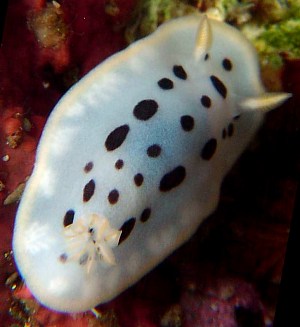
Dear Jun,
Sometimes you find animals which are much paler in colour than normal - in this case there seems to be a shortage of the yellow pigment. It is possible that the it is just a smaller animal, but I suspect is is just an unusual animal which for some reason is unable to produce the normal amount of yellow pigment.
Your upper photo is also interesting. Like the photos Nishina has just sent, it shows the black line on the inside edge of the gills.
Best wishes,
Bill Rudman
Chromodoris orientalis from Taiwan
July 24, 2001
From: Bernard Picton
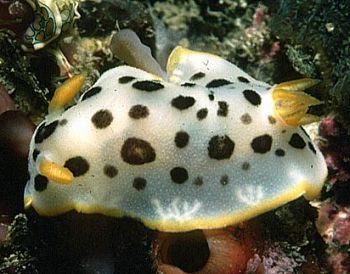
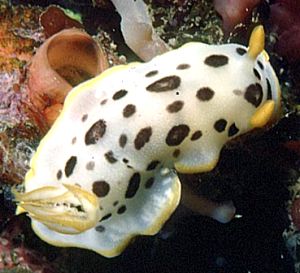
Hi Bill,
Lovely to see Leslie Chan's excellent photos from Hong Kong appearing on the site. I'd been meaning to send Chromodoris orientalis as it hadn't been added to the Forum until recently. It was common in Hong Kong in April 1983 when I collected there.
Here are two photographs showing the species in Taiwan, March 1983. The first photo shows the mantle glands very clearly and the texture of the surface.
Bernard
bernard.picton.um@nics.gov.uk
Picton, B., 2001 (Jul 24) Chromodoris orientalis from Taiwan. [Message in] Sea Slug Forum. Australian Museum, Sydney. Available from http://www.seaslugforum.net/find/4905Thanks Bernard,
This is another interesting record. As you say it is certainly good to get Leslie's photos. They have been the catalyst for me to start adding information from Brian Darvell's collections to the Forum, which I had been promising to do for some months.
Cheers,
Bill Rudman
Chromodoris orientalis from Hong Kong
July 15, 2001
From: Leslie Chan
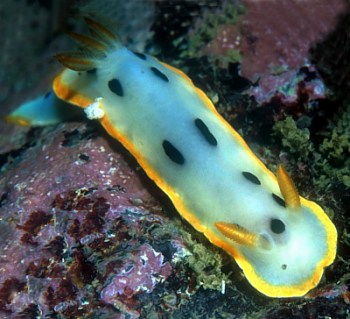
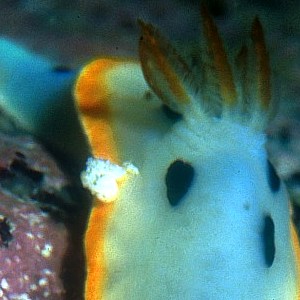
Dear Bill,
Could you identify this nudibranch which I photographed in Hong Kong.
Details: 15m, Shek Ngau Chau, Hong Kong. 25 October 2000.
Thanks
Leslie Chan
leslie@lesmart.com
Chan, L., 2001 (Jul 15) Chromodoris orientalis from Hong Kong. [Message in] Sea Slug Forum. Australian Museum, Sydney. Available from http://www.seaslugforum.net/find/4765Dear Leslie,
This is Chromodoris orientalis. The white mass on the edge of the mantle just in front of the gills is the exuded contents of a mantle gland. There is some debate about whether the chromodorid mantle glands have pores through which their contents can be released. Whether they do or don't, it is not unusual to find animals like this in which the contents of one or more glands has 'escaped'. If there are no structural pores, then it seems there are structural 'weak points' through which the gland contents can escape.
Best wishes,
Bill Rudman
Chromodoris orientalis from Hong Kong
July 15, 2001
From: Bill Rudman & Brian Darvell

To accompany Leslie Chan's photos, here is some information and photos on Chromodoris orientalis from Brian Darvell's Hong Kong collections.
PHOTO: Shelter Is. (SE), Port Shelter, 10 m., Hong Kong. [Site 10.10]. 4 June 1983, AM C140157. PHOTO: Brian Darvell.
The white background, large black spots and orange-yellow border to the mantle clearly distinguish this species. The foot is similarly coloured with a few scattered black spots and a row of orange spots along the edge. The rhinophore clubs and the edges of the gills are orange. It grows to at least 30 mm. Originally reported from Japan, as Chromodoris pallescens (Eliot, 1913) it has also been recorded from Hong Kong (Orr 1981; Rudman 1983).
Hong Kong Collection Records:
AM Cl33721, 28 February 1982, Site 8.17, Bluff Is. (NE), 6 m. AM C 133722, 3 specimens, 6 March 1982, Site 10. 18, Shelter Is. (SE), Port Shelter, 7-14 m. AM C135232, 11 July 1982, Site 8.31, Kong Tau Pai (N of Wang Chau), 9 m. AM C138130,2 January 1983, Site 8.38, Long Ke Wan (NE side), 6 m. AM C138131, 8 January 1983, Site 11.39, Tiu Chung Chau (SW), Port Shelter, 10 m. AM C138132, 2 specimens, 6 February 1983, Site 11.42, Ping Min Chau (S), Port Shelter, 11 m. AM C138133, 2 specimens, 20 February 1983, Site 9.44, reef, Rocky Harbour, 9 m. AM C140157, 4 June 1983, Site 10.10, Shelter Is. (SE), Port Shelter, 10 m. AM C142157, 2 specimens, 24 March 1984, Site I 1. I 00, rock E of Ma Tsai Pai, Rocky Harbour, 10 m. AM C145289, 2 specimens, 23 September 1984, Site 2.155, Round Is. (S), Mirs Bay, 12 m. AM C150349, 3 specimens, 4-20 April 1986, (Tolo Harbour, Mirs Bay). Depth range: 2-20 m.
Reference:
• Rudman, W.B. & Darvell, B.W. (1990) Opisthobranch molluscs of Hong Kong. Part 1. Goniodorididae, Onchidorididae, Triophidae, Gymnodorididae, Chromodorididae, (Nudibranchia). Asian Marine Biology, 7: 31-79.
Best wishes,
Bill Rudman & Brian Darvell
